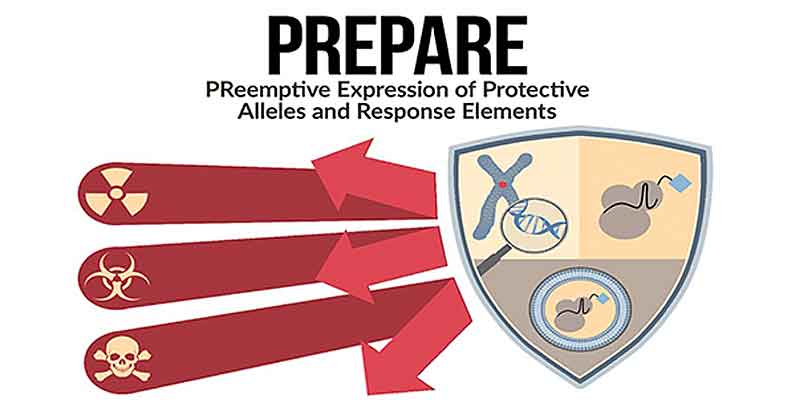
Did you know that protections against many common pathogens and environmental stressors are written into our DNA.
For instance our skin responds to sun exposure. Our immune system mounts defenses when we get the flu. Our bodies inherently work to mitigate the potential for harm caused by these health threats.
However, these intrinsic responses are not always quick, robust, or appropriate enough to adequately defend us from harm, which is why many people experience sunburn after intense sun exposure or suffer severe symptoms, even death, following exposure to the flu.
Military service members, first responders, and civilian populations face threats far more severe than sunburn and respiratory infections.
Pathogens with pandemic potential, toxic chemicals, and radioactive materials can all quickly and powerfully overwhelm the body’s innate defenses.
And though significant public and private investment has been focused on the development of traditional medical countermeasures such as drugs, vaccines, and biologics to guard against the worst effects of these health threats, current countermeasures are often limited in their effectiveness and availability during emergencies.
The Defense Advanced Research Projects Agency (DARPA), is looking to make gains beyond the status quo.

Inspired by recent advances in understanding of when and how genes express their traits, DARPA’s new PReemptive Expression of Protective Alleles and Response Elements (PREPARE) program will explore ways to better protect against biological, chemical, or radiological threats by temporarily and reversibly tuning gene expression to bolster the body’s defenses against – or directly neutralize – a given threat.
“The human body is amazingly resilient,” explained Renee Wegrzyn, the PREPARE program manager.
“Every one of our cells already contains genes that encode for some level of resistance to specific health threats, but those built-in defenses can’t always express quickly or robustly enough to be effective.”
“PREPARE will study how to support this innate resistance by giving it a temporary boost, either before or after exposure, without any permanent edits to the genome.”
The program will focus on four key health challenges as proofs of concept for what DARPA ultimately envisions as a generalizable platform that can be rapidly adapted to emerging public health and national security threats:
- Influenza viral infection
- Opioid overdose
- Organophosphate poisoning, and
- Exposure to gamma radiation
“Each of these four threats are major health concerns that would benefit from disruptive approaches,” Wegrzyn said.

“Seasonal flu vaccines, for example, are limited in that they try to hit a perpetually moving target, so circulating flu strains are often mismatched to vaccine strains.”
“Programmable modulation of common viral genome sequences could potentially neutralize many more circulating viral strains simultaneously to keep up with moving targets.”
“Combining this strategy with a temporary boost to host protection genes could change how we think about anti-virals.”
PREPARE requires that any treatments developed under the program have only temporary and reversible effects.
In so doing, PREPARE diverges sharply from recent gene-editing research, which has centered on permanently modifying the genome by cutting DNA and inserting new genes or changing the underlying sequence to change the genetic code.
Such approaches may cause long-lasting, off-target effects, and though the tools are improving, the balance of risk versus benefit means that these therapies are reserved for individuals with inherited genetic disorders with few to no other treatment options.
In addition, some indications, including treatment of pain, may only require temporary solutions, rather than life-long responses.

The envisioned PREPARE technologies would provide an alternative that preserves the genetic code exactly as it is and only temporarily modulates gene activity via the epigenome and transcriptome, which are the cellular messages that carry out DNA’s genetic instructions inside cells.
This would establish the capability to deliver programmable, but transient, gene modulators to confer protection within brief windows of time for meaningful intervention.
“Focusing only on programmable modulation of gene expression enables us to provide specific, robust protection against many threats at once, with an effect that carries less risk, is limited but tunable in duration, and is entirely reversible,” Wegrzyn said.
Success will hinge on developing new tools for targeted modulation of gene expression inside the body.
Researchers must identify the specific gene targets that can confer protection, develop in vivo technologies for programmable modulation of those gene targets, and formulate cell- or tissue-specific delivery mechanisms to direct programmable gene modulators to the appropriate places in the body.
Although the immediate program goal is to develop defenses against one of the four focus areas determined by DARPA, the ultimate objective of PREPARE is to develop a modular, threat-agnostic platform solution with common components and manufacturing architecture that can be readily adapted to diverse and emerging threats.
Research will be conducted primarily using computer, cell culture, organoid, and animal models to establish proof of concept.
However, DARPA’s vision is to generate new medical countermeasures for future use in humans. As such, DARPA is working with independent bioethicists to identify and address potential ethical, legal, and societal issues.
By the end of the four-year program, DARPA aims for each funded team to submit at least one final product to the U.S. Food and Drug Administration (FDA) for regulatory review as an Investigational New Drug or for Emergency Use Authorization.
Throughout the program, teams will be required to work closely with the FDA to ensure that the data generated and experimental protocols meet regulatory standards.
(Learn More. Since its inception in 1958, DARPA has held to a singular and enduring mission: to make pivotal investments in breakthrough technologies for national security. Courtesy of DARPA and YouTube. Posted on Jan 16, 2018)
DARPA will hold a Proposers Day on June 13, 2018, in Arlington, Va., to provide more information about PREPARE and answer questions from potential proposers.
The Biological Technologies Office (BTO) of the Defense Advanced Research Projects Agency (DARPA) is hosting a Proposers Day for the potential proposer community in support of a planned Broad Agency Announcement (BAA) for the PReemptive Expression of Protective Alleles and Response Elements (PREPARE) Program.
The Proposers Day will be held on June 13, 2018 from 8:00 AM to 5:00 PM ET at the Westin Arlington Gateway hotel in Arlington, VA. Advance registration is required.
The goals of the Proposers Day include:
1. Introducing the PREPARE program vision and goals;
2. Explaining the mechanics of a DARPA program in general and the objectives and milestones of this program in particular; and
3. Encouraging and promoting teaming arrangements among organizations that have the relevant expertise, research facilities, and capabilities for executing research and development responsive to the PREPARE program goals.

















